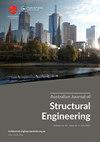An experimental study on mechanical behaviour of concrete by partial replacement of sand with brick fines
IF 1.3
Q4 ENGINEERING, CIVIL
Australian Journal of Structural Engineering
Pub Date : 2023-11-02
DOI:10.1080/13287982.2023.2269633
引用次数: 0
Abstract
ABSTRACTHeat is one of the primary factors that causes concrete structures to deteriorate over time and enhance concrete’s structural properties. In an experimental investigation, brick fines were substituted for sand at different percentages of 5%, 10%, 15%, and 20% to test the mechanical behaviour of concrete exposed to high temperatures. At 15% replacement of brick powder, the maximal strength at standard temperatures had attained. An optimal concrete and ordinary concrete had then been exposed for 2 h at temperatures ranging from 100°C to 600°C at 100°C intervals. The quality check and strength characteristics of replacement and conventional concrete were evaluated, including weight loss, Ultrasonic Pulse Velocity (UPV), rebound hammer, and compressive, tensile, and flexural strengths at ambient and high temperatures. The quality of concrete decreased with temperature increase because of crack development and incompatible deformation between aggregate and cement paste. The strength decreased with increased temperature because of calcium silicate hydrate (CSH) breakdown and capillary water evaporation. Furthermore, a particular temperature at which cracks appear in concrete specimens exposed to high temperatures had determined using Scanning Electron Microscopy (SEM) and Energy Dispersive Spectroscopy (EDS) analyses. The brick powder performed better in enhancing the concrete’s strength characteristics after being heated.KEYWORDS: Brick finescompressive strengthelevated temperatureenergy dispersive spectroscopy analysisflexural strengthscanning electron microscopy analysis Disclosure statementNo potential conflict of interest was reported by the author(s).Availability of dataData available on request from the authors.PolicyBasic, share upon request.Data availability statementThe data that support the findings of this study are available from the corresponding author, [author initials], upon reasonable request.Author Contribution StatementSweety Poornima Rau: Conceptualisation; Data curation; Investigation; Methodology; Resources; Writing original draft; Review and writing;M. Manjunath: Visualisation; Supervision; Formal analysis; Project administrationThe corresponding author is responsible for ensuring that the descriptions are accurate and agreed by all authors.The role(s) of all authors listed using the above relevant categories.Authors may have contributed in multiple roles.Credit in no way changes the journal’s criteria to qualify for the authorship.Statements and DeclarationsOn behalf of all authors, the corresponding author states that there is no conflict of interest.砖粉部分替代砂对混凝土力学性能的试验研究
高温是导致混凝土结构随着时间的推移而恶化并增强混凝土结构性能的主要因素之一。在一项实验研究中,用砖粉代替5%、10%、15%和20%不同比例的沙子,测试高温下混凝土的力学性能。砖粉掺入量为15%时,达到了标准温度下的最大强度。然后将最佳混凝土和普通混凝土在100°C至600°C的温度范围内暴露2小时,间隔为100°C。对替代混凝土和常规混凝土的质量检查和强度特性进行了评估,包括失重、超声脉冲速度(UPV)、回弹锤、环境和高温下的抗压、抗拉和抗弯强度。随着温度的升高,混凝土的质量下降,主要是由于骨料与水泥浆体之间的不协调变形和裂缝的发展。由于水合硅酸钙(CSH)的分解和毛细管水分蒸发,强度随温度升高而降低。此外,使用扫描电子显微镜(SEM)和能量色散光谱(EDS)分析确定了高温下混凝土试样出现裂缝的特定温度。砖粉加热后对混凝土的强度特性有较好的增强作用。关键词:砖细;抗压强度;高温;能量色散光谱分析;可根据作者的要求获得数据数据。PolicyBasic,应要求共享。数据可获得性声明支持本研究结果的数据可根据合理要求从通讯作者[作者首字母缩写]处获得。作者贡献声明sweety Poornima Rau:概念化;数据管理;调查;方法;资源;撰写原稿;复习与写作;希:可视化;监督;正式的分析;项目管理通讯作者负责确保描述的准确性并得到所有作者的同意。使用上述相关类别列出的所有作者的角色。作者可能扮演了多种角色。署名不会改变期刊对作者资格的标准。声明和声明我代表所有作者,通讯作者声明不存在利益冲突。
本文章由计算机程序翻译,如有差异,请以英文原文为准。
求助全文
约1分钟内获得全文
求助全文
来源期刊

Australian Journal of Structural Engineering
ENGINEERING, CIVIL-
CiteScore
2.50
自引率
0.00%
发文量
31
期刊介绍:
The Australian Journal of Structural Engineering (AJSE) is published under the auspices of the Structural College Board of Engineers Australia. It fulfils part of the Board''s mission for Continuing Professional Development. The journal also offers a means for exchange and interaction of scientific and professional issues and technical developments. The journal is open to members and non-members of Engineers Australia. Original papers on research and development (Technical Papers) and professional matters and achievements (Professional Papers) in all areas relevant to the science, art and practice of structural engineering are considered for possible publication. All papers and technical notes are peer-reviewed. The fundamental criterion for acceptance for publication is the intellectual and professional value of the contribution. Occasionally, papers previously published in essentially the same form elsewhere may be considered for publication. In this case acknowledgement to prior publication must be included in a footnote on page one of the manuscript. These papers are peer-reviewed as new submissions. The length of acceptable contributions typically should not exceed 4,000 to 5,000 word equivalents. Longer manuscripts may be considered at the discretion of the Editor. Technical Notes typically should not exceed about 1,000 word equivalents. Discussions on a Paper or Note published in the AJSE are welcomed. Discussions must address significant matters related to the content of a Paper or Technical Note and may include supplementary and critical comments and questions regarding content.
 求助内容:
求助内容: 应助结果提醒方式:
应助结果提醒方式:


